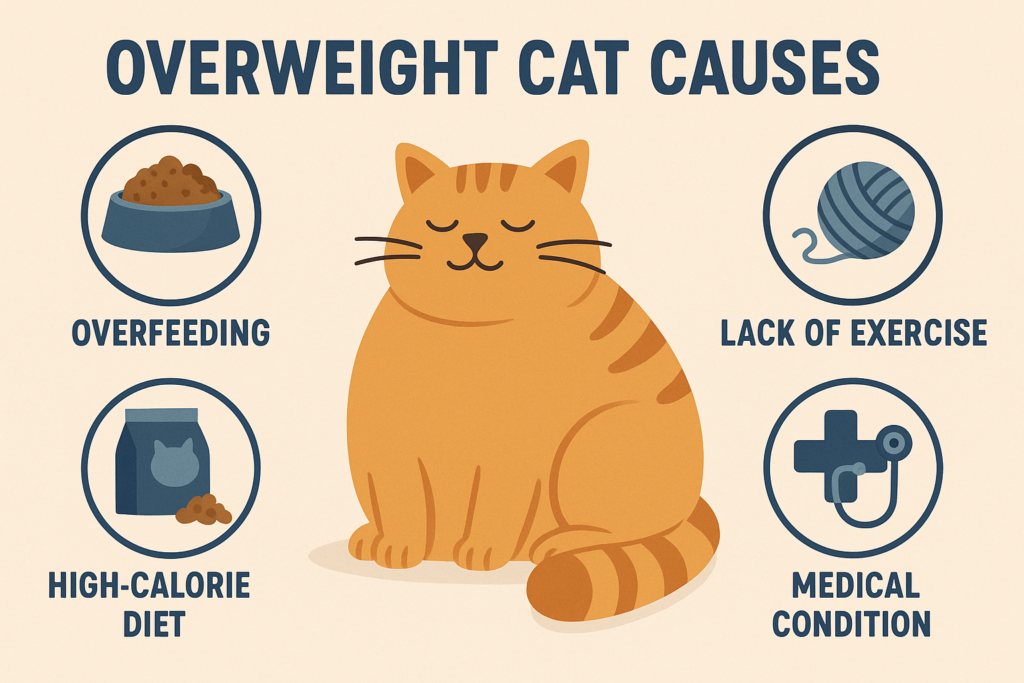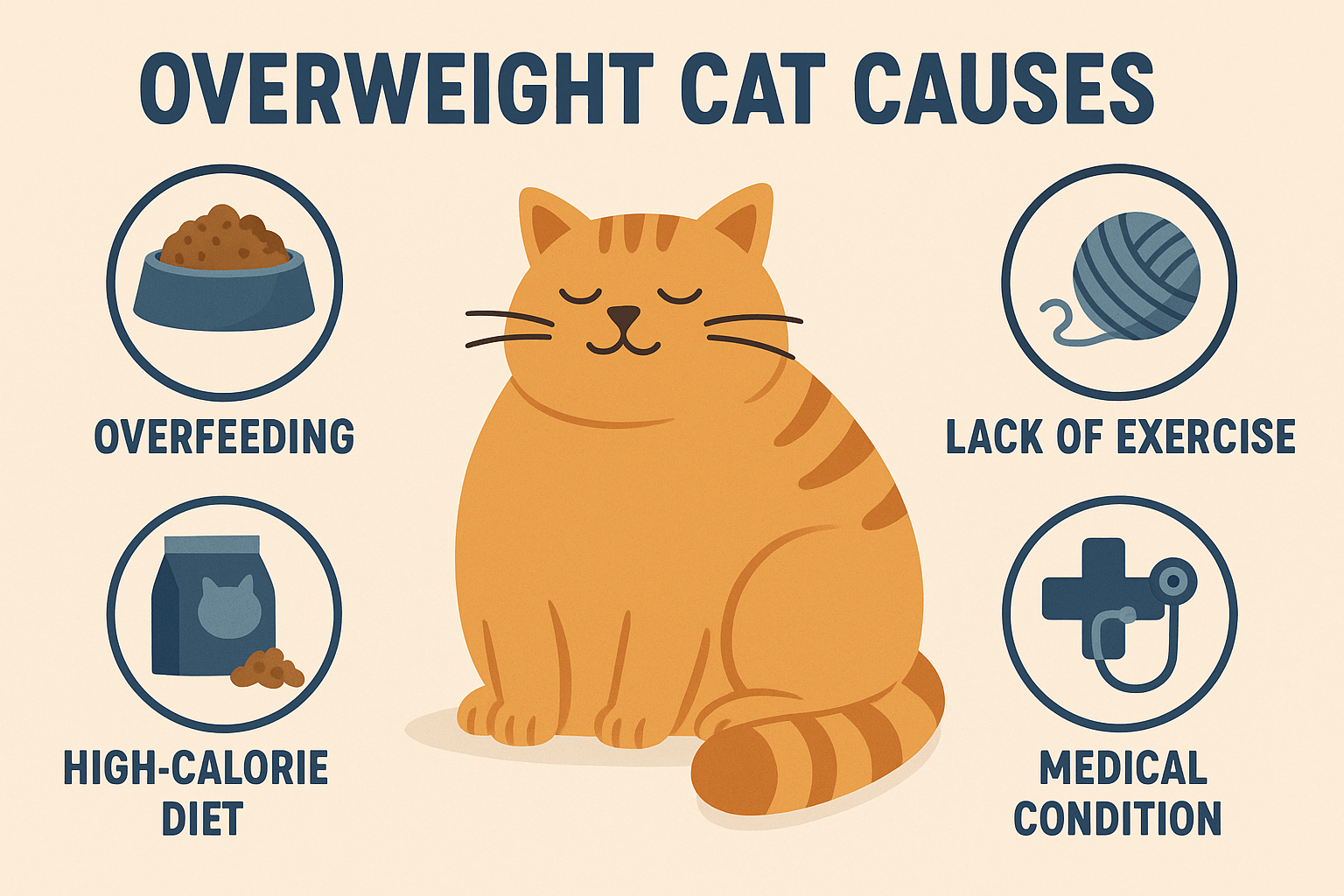Overweight Cat Causes: Understanding the Root of the Problem
Cats bring joy and companionship into our lives, but when they become overweight, it can lead to serious health concerns. An overweight cat is not just a cute, fluffy companion—it’s a sign that something in their lifestyle or diet needs adjustment. Obesity in cats can result from a variety of factors, including overfeeding, lack of exercise, and even underlying medical conditions. As responsible pet owners, it’s crucial to understand the causes behind this growing issue so we can take proactive steps to ensure our feline friends stay healthy and happy. Let’s dive into the reasons why cats gain weight and how you can address these challenges effectively.
Expert Insight: The Impact of Fat on Inflammation and Oxidative Stress
“Fat secretes inflammatory hormones and produces oxidative stress in tissues and organs. Oxidative stress occurs when there are excessive free radicals in the body and not enough antioxidants to get rid of them. This can damage organs and tissues and may result in various diseases.”
Common Causes of Overweight Cats
Understanding the root causes of feline obesity is the first step toward prevention. Several factors contribute to why your cat might be carrying extra pounds, and addressing these issues can make a significant difference in their overall health.
Overfeeding:
Many cat owners unintentionally overfeed their pets, either by giving too many treats or misjudging portion sizes during mealtime.Lack of Exercise:
Indoor cats often don’t get enough physical activity, leading to a sedentary lifestyle that contributes to weight gain.High-Calorie Diets:
Feeding your cat calorie-dense foods without proper portion control can quickly lead to excessive weight gain.Free Feeding Practices:
Leaving food out all day for your cat to graze on can result in overeating, especially if they’re prone to snacking.Underlying Health Conditions:
Certain medical issues, such as hypothyroidism or diabetes, can cause hormonal imbalances that lead to weight gain.
By identifying and addressing these common causes, you can take meaningful steps to help your cat achieve and maintain a healthy weight.

Signs Your Cat May Be Overweight
Recognizing the signs of an overweight cat is essential for early intervention. If you suspect your cat is gaining weight, look out for these telltale indicators.
Visible Fat Pads:
Excess fat around your cat’s abdomen or at the base of their tail can indicate they’re carrying extra weight.Difficulty Grooming:
Overweight cats often struggle to reach certain areas of their body for grooming, leading to matted fur or poor hygiene.Reduced Energy Levels:
A noticeable decline in playfulness or lethargy may suggest your cat is weighed down by excess pounds.Inability to Feel Ribs Easily:
You should be able to feel your cat’s ribs with gentle pressure—if you can’t, they may be overweight.Shortness of Breath:
Cats carrying extra weight may pant or breathe heavily after minimal physical activity.
Spotting these signs early allows you to take action before your cat’s weight becomes a more serious health concern.
Check this guide 👉Why Does My Cat Eat Everything? Best 7 Behavior Tips!
Check this guide 👉Why Is My Cat Eating Litter? Best 7 Expert Tips!
Check this guide 👉Can My Cat Eat Raw Salmon? Best 7 Expert Tips!
Preventive Measures for Overweight Cats | Health Risks of Feline Obesity |
|---|---|
Portion-controlled meals | Increased risk of diabetes |
Scheduled playtime sessions | Joint problems and arthritis |
Avoiding high-calorie treats | Heart disease and respiratory issues |
Regular vet check-ups | Reduced lifespan and quality of life |
Providing interactive toys | Difficulty grooming and skin infections |
How to Help Your Cat Lose Weight Safely
Helping your cat shed excess weight requires a thoughtful approach that prioritizes their health and well-being. Here are some strategies to guide you through the process.
Consult Your Veterinarian:
Before starting any weight loss plan, consult your vet to rule out underlying health issues and create a tailored plan for your cat.Adjust Their Diet Gradually:
Transition to a balanced, low-calorie diet over time to avoid digestive upset while ensuring your cat receives essential nutrients.Measure Food Portions Accurately:
Use a kitchen scale or measuring cup to provide precise portions, preventing accidental overfeeding.Limit Treats and Snacks:
Reserve treats for training or special occasions, and opt for healthier alternatives like small pieces of cooked chicken.Encourage Physical Activity:
Engage your cat with interactive toys, laser pointers, or climbing structures to encourage movement and burn calories.
With patience and consistency, these steps can help your cat lose weight safely and improve their overall quality of life.
The Role of Environment in Feline Obesity
A cat’s environment plays a significant role in their likelihood of becoming overweight. Addressing environmental factors can help prevent weight gain and promote a healthier lifestyle.
Indoor vs. Outdoor Living:
Indoor cats are more prone to obesity due to limited opportunities for physical activity compared to outdoor cats.Availability of Play Spaces:
Creating vertical spaces like cat trees or shelves encourages climbing and exploration, keeping your cat active.Routine and Consistency:
Establishing a consistent feeding and play schedule helps regulate your cat’s metabolism and energy levels.Stress-Free Environment:
A calm and enriching home reduces stress-related overeating, which can contribute to weight gain.Social Interaction:
Spending quality time with your cat through play or affection strengthens your bond and motivates them to stay active.
By optimizing your cat’s environment, you can support their physical and mental well-being while reducing the risk of obesity.
The Role of Environment in Feline Obesity
A cat’s environment plays a significant role in their likelihood of becoming overweight. Addressing environmental factors can help prevent weight gain and promote a healthier lifestyle.
Indoor vs. Outdoor Living:
Indoor cats are more prone to obesity due to limited opportunities for physical activity compared to outdoor cats.Availability of Play Spaces:
Creating vertical spaces like cat trees or shelves encourages climbing and exploration, keeping your cat active.Routine and Consistency:
Establishing a consistent feeding and play schedule helps regulate your cat’s metabolism and energy levels.Stress-Free Environment:
A calm and enriching home reduces stress-related overeating, which can contribute to weight gain.Social Interaction:
Spending quality time with your cat through play or affection strengthens your bond and motivates them to stay active.
By optimizing your cat’s environment, you can support their physical and mental well-being while reducing the risk of obesity.
Fun Ways to Keep Your Cat Active
Keeping your cat active doesn’t have to feel like a chore—there are plenty of fun and engaging ways to encourage movement.
Interactive Toys:
Feather wands, laser pointers, and puzzle feeders stimulate your cat’s hunting instincts.DIY Obstacle Courses:
Create a simple course using boxes, tunnels, and shelves to spark curiosity and exploration.Scheduled Play Sessions:
Dedicate 10-15 minutes twice daily to focused playtime, ensuring consistency.Catnip Incentives:
Use catnip-infused toys or sprays to entice your cat into playing more vigorously.Window Perches:
Install perches near windows to let your cat watch birds and squirrels, keeping them mentally stimulated.
These activities not only burn calories but also strengthen the bond between you and your cat.
Tips for Managing Multi-Cat Households
In homes with multiple cats, managing weight can be challenging, especially if one cat is prone to overeating. These tips can help you navigate this unique situation.
Separate Feeding Areas:
Designate individual feeding stations to prevent food stealing or competition.Monitor Food Intake Closely:
Track each cat’s consumption to ensure no one is overeating or undereating.Use Microchip Feeders:
Automated feeders programmed to recognize specific cats can dispense controlled portions.Provide Equal Attention:
Ensure all cats receive equal playtime and affection to reduce stress-related behaviors.Tailor Diets Individually:
Adjust diets based on each cat’s age, activity level, and health needs rather than applying a one-size-fits-all approach.
With careful planning and observation, you can maintain harmony and health in a multi-cat household.
Frequently Asked Questions About Overweight Cats
What is a healthy weight for my cat?
A healthy weight varies by breed, but most domestic cats should weigh between 8-10 pounds. Consult your vet for personalized guidance.
Can neutering or spaying cause weight gain?
Yes, these procedures can slow metabolism, making it important to adjust your cat’s diet and activity levels accordingly.
How long does it take for a cat to lose weight?
Safe weight loss occurs gradually, typically about 1% of their body weight per month, under veterinary supervision.
Are certain cat breeds more prone to obesity?
Yes, breeds like Maine Coons and Ragdolls may be more susceptible due to their larger size and slower metabolisms.
What if my cat refuses to eat diet food?
Mix small amounts of the new food with their regular food, gradually increasing the proportion until they adjust.
Taking Action for Your Cat’s Health
An overweight cat is more than just a minor inconvenience—it’s a call to action for better care and attention. By understanding the causes of feline obesity and implementing preventive measures, you can significantly improve your cat’s quality of life. From adjusting their diet to creating an enriching environment, every small change makes a big difference. Remember, your cat relies on you to keep them healthy and happy, and taking proactive steps today ensures they’ll thrive for years to come. With love, patience, and dedication, you can help your furry friend achieve their ideal weight and enjoy a vibrant, active life.
Can a Cat Die from a Cold? Best 7 Expert Tips! Learn how to identify, treat, and prevent feline colds while understanding when to seek veterinary care for your cat’s health.
Cat Screaming for Food: Best 7 Expert Tips! Discover effective strategies to manage your cat's food-related vocalizations and create a peaceful feeding routine.
Aspiration Pneumonia in Cats: Best 7 Expert Tips! Discover causes, symptoms, and treatment advice to protect your cat’s respiratory health and ensure a speedy recovery.
Hip Dysplasia in Cats: Best 7 Expert Tips! Discover expert advice on managing hip dysplasia in cats, from symptoms and prevention to treatment options for a happier, healthier feline life.





